Transcription of Family-Guided SS-OO-PP-RR Home Visiting - DMM
1 Family-Guided SS-OO-PP-RR home Visiting I. Setting the Stage: The activities listed under setting the stage may take place in the first few minutes of the visit or may be interspersed throughout the visit. There is no one right way just the way that works the best for the family and you. Sometimes when you arrive, you will find the family in the middle of an activity such as clearing the table and can just join in with the child and parent catching up on what has been happening while observing the child s first routine of the day. Other times the family will be waiting for your arrival and will anticipate starting with a preferred activity.
2 Some families prefer a predictable home visit sequence while others are spontaneous and many others are variable depending upon the day. What is important is that you gather and give information with the family to support the child s success, the family s participation and satisfaction, and everyone s ability to interact with the child to enhance accomplishment of the family priorities. a. Greetings Greet family members and confirm appointment, goals and plans for the day. , Hi everyone. How is the day going so far? Are we ready for snack or is it time to go outside to play? b. Child and family Outcome Update Assess child and family well being How has Laura been?
3 Did her cold go away? Is grandma out of the hospital? Has Dad gotten any break from overtime duty? Review activities from the last visit During our last visit, we tried using the choice board to reduce temper tantrums during getting dressed. How did it go? You were going to try putting the snack choice board on the refrigerator. How did that work? We played on the swings and in the sandbox last week. Did he ask for more? Get reactions to activities since last visit. Identify family s satisfaction. How did using the toy grocery cart work for increasing her walking? Did she chase you? Did you have fun?
4 Ask questions that help the family reflect on their enjoyment and ability to be with their family doing every day activities rather than extra or therapy type work. Did bath time take longer when you added big brother as a conversation partner? Did your family enjoy going to the park? How much extra time was involved with Danny helping put the clothes away? Revisit child outcomes on IFSP and solicit family feedback on child s current status to keep the big picture in focus. We re working on Cara s vocalizations to help her develop words. What sounds have you heard this week? Is this still a priority?
5 Collect data on progress toward family outcomes Have you had a chance to look through the information on nutrition for children with Down syndrome? Do you have any questions? Did you hear back from the Early Head Start program about part time work opportunities for you? Offer emotional support Last week you mentioned thinking about how to share Alden s autism diagnosis with friends and relatives, is that something you d like to discuss today? Identify program revision needs 1. Monitor supports: Were the services actually delivered? Did the respite provider come? or Do you think it is going to work?
6 2. Listen to family s changing or newly identified concerns and priorities 3. Discuss changes necessary to accommodate new interests 4. Brainstorm new strategies; facilitate problem solving. Talk about what support the family will need to implement a plan. 5. Agree on responsibility for implementation and on time lines. , What is your best guess for a time next week? How soon do you want to be done? I can bring information next week. Will that work for you? c. Review previous plans and organize for the visit Discuss purpose of visit, soliciting family s ideas. , Last week we planned to.. Does that still meet your needs?
7 " "Is there anything else?" Ask open-ended, non-intrusive questions reflective of your relationship. (Some families are more formal with providers and others are more casual.) , How has everything been going? How s your week been? Any excitement? "Is there any information you want? Agree upon general plan and time allotments for each activity if needed. Encourage joining current activity of child and caregiver. "Where do you want to start? Should we finish up what you were doing?" Ask parent to identify any places of the house or yard appropriate for interaction based on activities identified. (This is a great time to suggest new locations that might enhance additional practice opportunities and generalization.)
8 , kitchen for snack and meal routines, playroom for general activities, bedroom for dressing routines. You can also suggest warm weather activities like the backyard wading pool or pretend play activities that use a box from the store as a house or a sheet over the table as a tent. Try to expand gently and explain why. II. Observation and Opportunities to Practice: It is likely that for most visits, the majority of time will be spent in the actual activities and routines with the parent and child. Your role will depend upon the relationship you have established with the family , the family s priorities, and the support both the child and parent needs from you during the visit.
9 Your role will also vary across routines and the coaching strategies that you use. Because the relationships and roles are dynamic, the home visit should be as well. Remember, one of the goals for early intervention is to support the family s ability to maximize their child s potential, helping them to be empowered in their child s learning process. Systematically and deliberately seek to empower the family . a. Arrange physical environment to promote parent-child interaction Join in to ongoing activities while gathering child and family updates Position self for easy observation and interaction with parent and child as a dyad without interrupting or intruding Use materials available and typical for child and family Identify/ suggest materials that are interesting and interactive for the dyad Move with child and caregiver between activities Support child physically to engage with parent Ask caregiver s input about comfort and ease of activity Suggest adaptations or rearrangements as needed b.
10 Share information by connecting what caregivers are doing to child goals and opportunities for learning Explain the purpose of activity in relationship to child s development Describe development of child and impact of disability Describe what the child is learning within each routine and why it is important Suggest strategies for increasing participation and independence in current goals Practice activity with the family and share what you see while observing Share information on successful interventions to help children learn Offer choices of strategies and discuss pros and cons of each Problem solve with caregivers new or expanded routines for embedding goals c.








